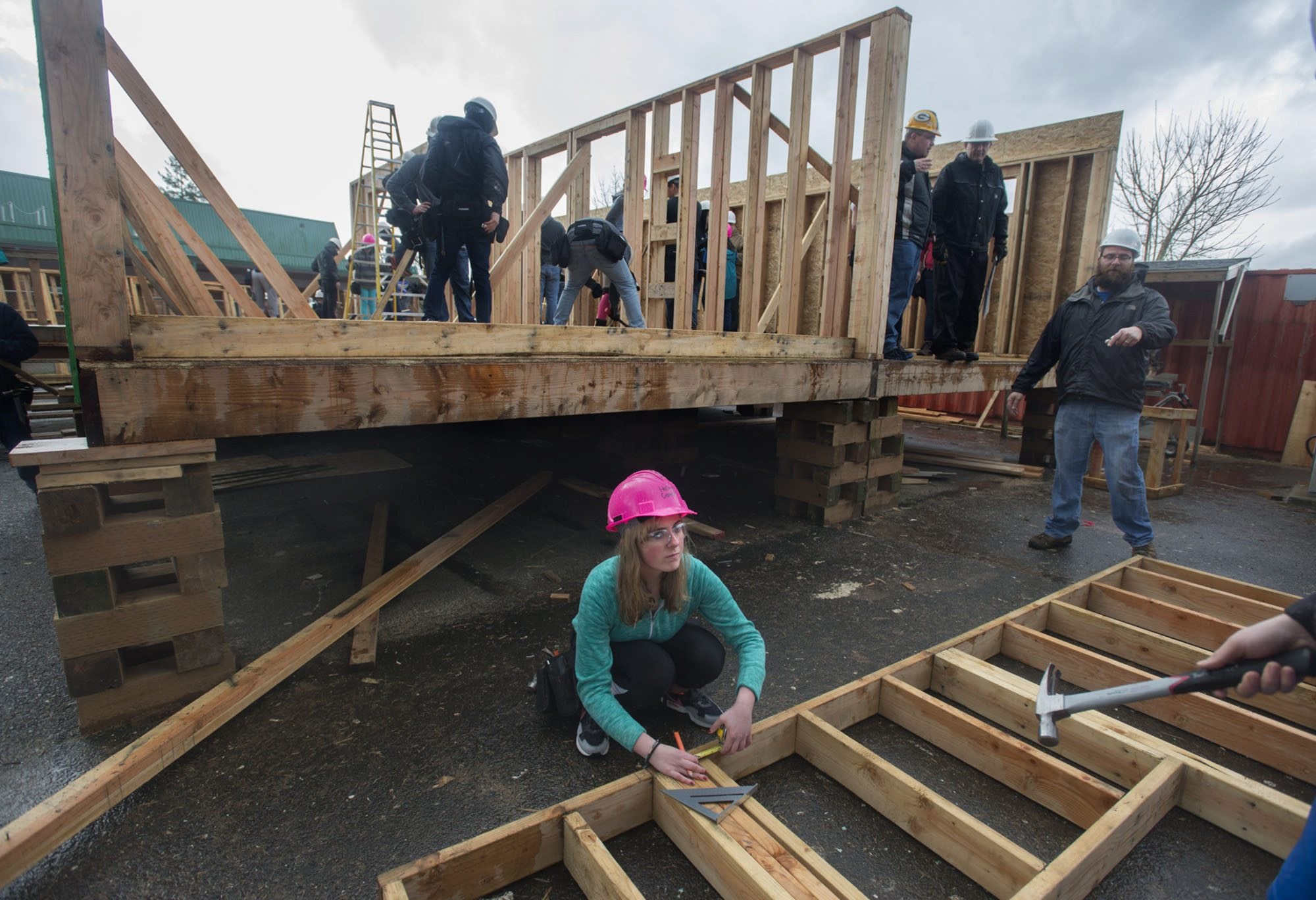Backs bent against the pelting rain, half a dozen construction workers grabbed a framed-out wall and hoisted it four feet into the air onto the floor deck of the home they were building.
After the wall was positioned, another team pounded nails into the floor plate to secure the wall. Eventually, the structure will become an 1,100-square-foot home built for a low-income family through a partnership with Habitat for Humanity.
The construction crew members were not seasoned professionals, but Evergreen High School students enrolled in the Geometry in Construction program, which combines geometry with real-world home construction experience, said John Akers, Evergreen Public Schools’ program manager of College, Career and Technical Education. Wearing a hard hat, Akers was at the construction site watching students work.
“The primary goal of the program is to provide students a way to see the math working in a very real way,” said Bill Culver, who teaches the class at Evergreen High.
Update
• Previously:Geometry in Construction students at Mountain View and Evergreen high schools teamed with Habitat for Humanity to build a modular house. Each school built half of a home, and then the two halves were hauled to a Habitat construction site and joined into one home.
• What’s new:This year, each school is building its own home for Habitat.
• What’s next:Later this year, the finished homes will be divided in half for easier transport and be moved to a 10-lot Habitat subdivision in the Vancouver Heights neighborhood.
But as they build a house, students also learn the concepts of productivity, quality control and teamwork, he said.
About 45 Evergreen High students and 80 Mountain View High School students are taking the class this year. Since its inception five years ago, about 600 students have taken the class. It’s the third year the school district has worked with Habitat for Humanity.
“It’s been an amazing partnership,” said Josh Townsley, executive director of Habitat for Humanity, who was on hand watching the students. “We get the opportunity to work with amazing kids. They learn building skills, work as a team and give back to the community.”
Working with youth also opens up new funding opportunities for Habitat, such as educational grants, Townsley added.
Very few high schools nationwide are building houses for Habitat for Humanity. Evergreen Public Schools based its program on the The Geometry in Construction program created by Loveland High School in Loveland, Colo.
In the past two years, Evergreen and Mountain View each built half a house, which were then hauled to the homesite and joined together. This year, students at each school will build a complete house. Each house will be divided into two parts and moved to a 10-unit subdivision in the Vancouver Heights neighborhood.
Evergreen Habitat for Humanity provides blueprints and all construction materials. Students do most of the work on the houses on their school campuses, but electrical and plumbing must be done by licensed contractors. Professional structure movers will haul the homes to the land owned by Habitat for Humanity, where a foundation is laid by professionals. Habitat pays about $85,000 per house for materials, subcontractors and moving the homes, said Townsley.
Making walls fit
Wearing a hard hat with “The Boss” scrawled on it, instructor Culver directed a team of students to lift up a framed-out exterior wall that was on the deck. But when the students lifted the wall, it didn’t fit into the tight space between another exterior wall and an interior wall. They set the framed-out wall back down. Students measured and discovered the space between the two walls was one-quarter inch too short for the framed-out wall to fit.
“Guess what tables 10, 12 and 14 are doing next?” Culver announced.
He directed those teams to move the already attached interior wall one-quarter inch. Wielding crowbars, students pulled out nails securing the interior wall. Then several students lifted the wall one-quarter inch to the west. Another set of measurements indicated success. Students pounded nails into the floor plate to secure the interior wall in its new space.
Meanwhile, another team of students corrected errors on the framed-out exterior wall that didn’t fit. The top plate had been attached backwards, so students removed it, turned it around and reattached it to the framed-out wall.
Culver worked with students as they measured again to ensure the wall would fit into the space. The wall was still one-eighth-inch too large for the space.
“Where’s the sledgehammer?” Culver asked.
A student handed the tool to the teacher, who swung the sledgehammer to move the framed interior wall a fraction of an inch further.
Culver and the students measured again.
“Now it will fit,” Culver said, smiling.
“The program puts front and center the concept of helping our community in a tangible way,” he said. “These students will be able to positively impact the well-being of an individual family within our community for the rest of that family’s life. That is a very powerful statement.”
Emily Kessinger, 16, a team leader who helped build the house last year, said, “It was eye-opening when I saw how much it helped the family last year. I wanted to come back.”
“It’s honestly pretty fun to be doing this for other people,” said Austin Housel, 15. “It makes me feel happy.”




